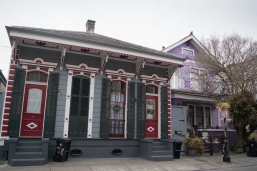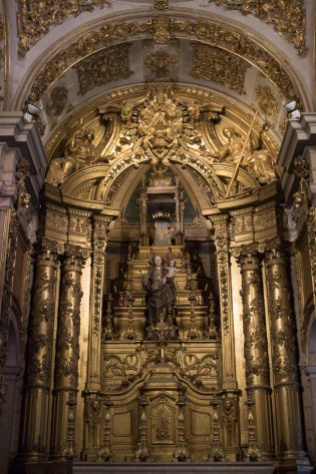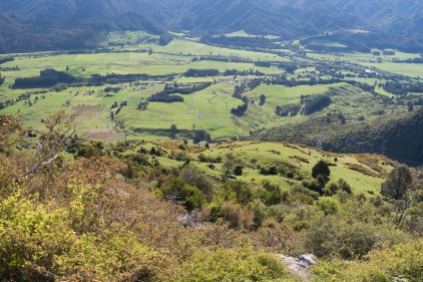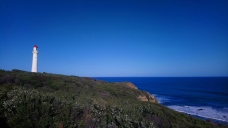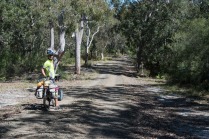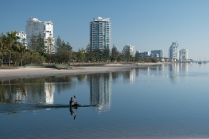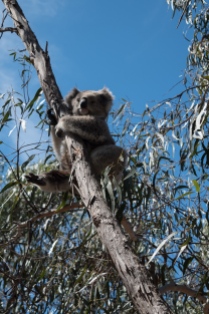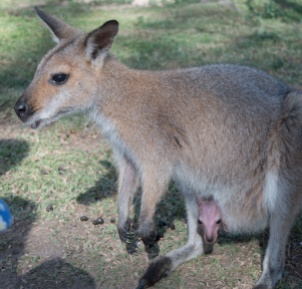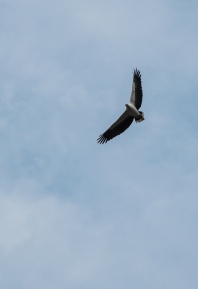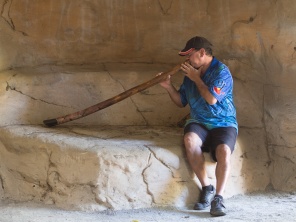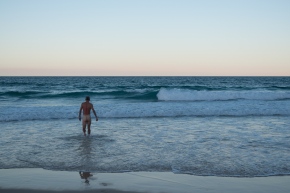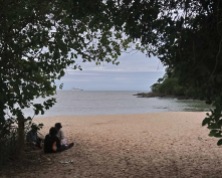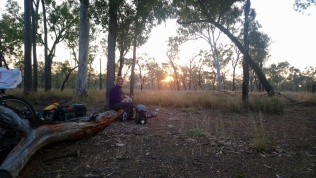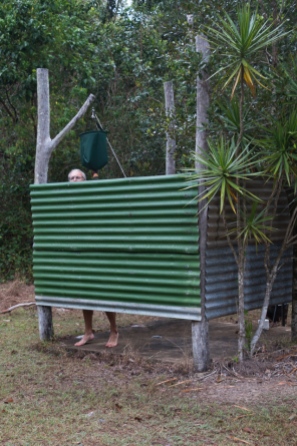Category Archives: Australasia
The Green and the Grey – New Zealand
‘South Island, Mum. You’ve got to visit the South Island. The North Island is all very beautiful, but it’s just like Wales. You’ve seen it all before . It’s the South Island that’s spectacular.’ These sentiments were reiterated several times but so were the warnings of steep windy roads and heavy traffic. The main highway from Christchurch is closed due to the November 2016 earthquake. This diverted all the commercial traffic up the smaller twisty central highway. ‘No place for a bicycle’ we were warned. Mind you, we’ve had a lot of warnings like that.
We went for a compromise. An outdoor pursuits instructor in Christchurch had recommended the South Island’s northern coastline going from Picton via Nelson west out towards the Golden Bay. He reckoned it was one of his favorite rides; it also passed the test of my daughter who had liked it out there. So having flown into Wellington, we took the ferry and buses out to Takaka, and cycled a little further west to get a better view of Golden Bay before turning around to start our New Zealand leg for real.
Our route back took us over the Takaka pass. At 791m it’s a mere babe of a mountain alongside the many big sisters reaching 3000 m or more. Two such snow capped beauties we admired whilst looking out across Havelock’s inlet.
The Tasman’s Great Taste Trail, where we admired the views from the top of the ridge before sweeping back down to the coast and crossing the river, was our first experience of New Zealand’s many bike trails. The ferry from Mapua delivered us to the deserted estuary beach where sand and shingle replaced gravel tracks and bitumen, as we wound our way across the deserted island.
Thus we’d started our NZ trip but the honeymoon period was over. Half a dozen rain spots was all we’d felt so far but that was about to change. The Scottish game we call it having spent two weeks of 2014 cycling up to John O’Groats with the on/ off rain kit syndrome. Cycle for ten mins; it’s raining, on goes the rain kit. Thirty mins later it’s dry; off comes the rain kit. Thirty mins later – it’s raining- on goes the rain kit. Ten mins later it’s stopped, off comes the rain kit. This interspersed with whole days of continuous rain was what we were in for.
Official advice on the New Zealand bike trails site is, ‘take rain proofs and a sense of humor – you never know you might enjoy cycling in the rain’. Coffee culture in NZ where even tiny villages have a café that we could cower in certainly helped.
We’re no lightweights when it comes to outdoor pursuits in rain having spent five whole days in continuous rain on a sea kayaking trip in Alaska and four days hiking in a rain forest in Vancouver Island but cycling is possibly the trickiest because of the changing levels of exertion required to climb hills and mountains, pedal along the flat, or freeze on long downhills. In heavy rain it’s easy to keep cool but in drizzle and light rain it’s not long before you are wondering if it’s leaky rain clothes or sweat that’s soaking you to the bone. When you can see them the views in the rain are very atmospheric with trees and hill tops poking up above the clouds.
The must do Tongariro Alpine Crossing, with its stunning snow capped volcano, craters, sulphur lakes and alpine views was fantastic. It’s a 19.4km one day hike across a mountains pass. Boots not bikes, is definitely counted as a rest day but I’m not sure our legs were convinced! The day started in perfect sunshine but this didn’t last. A couple of hours into the walk the cloud closed in. Fortunately we’d already snapped away at Mount Ngauruhoe and we’re lucky that the cloud cover lifted enough for us to enjoy views of the Red Crater and Emerald lakes. The alpine views on the downward path swept before us like flicker cards presenting the scene as the cloud, and by now drizzle, wafted past.
Calamity! 19.4km afoot makes for a pretty tiring day, and Clare dozed off in the shuttle bus on the way home. As she snored, her bag fell over, and her battered, cracked, scraped, but still working camera ended up in a puddle inside the bag. End of camera.
A couple of days later we tackled the Timber Trail. It’s an easy grade 2/3 mountain bike ride, which was an obvious choice to get a taste of a full length bike trail, especially with the added attraction of crossing eight suspension bridges.
A solid day of rain before we started ensured the mud levels were at their best. Sections of it were slow and exasperating as we slipped and slid along the track, frequently shoving the bikes through squelching mud. Information boards presented the history of the logging industry in the area while the two days of sunshine, and respite from the rain, kept our spirits up.
Our last few days of riding in New Zealand continued in the same vein – pretty hilly and rather damp. There’s an old saying about no bad weather, just bad gear, but it does slow you down. Fortunately we still made it to the camera shop in time to pick up the ordered replacement. And on our very last riding day the hills receded into the distance as we dropped down a scenic gorge, then traversed agricultural plains – with no headwind and no rain! We never quite made it to Auckland, meeting up with emigrated old friends Sally & Stuart near Hamilton. We decided to duck the logistical and timescale challenges of getting in and out of Auckland with boxed bikes, and gratefully accepted a lift to the airport, ready (really?) for America.
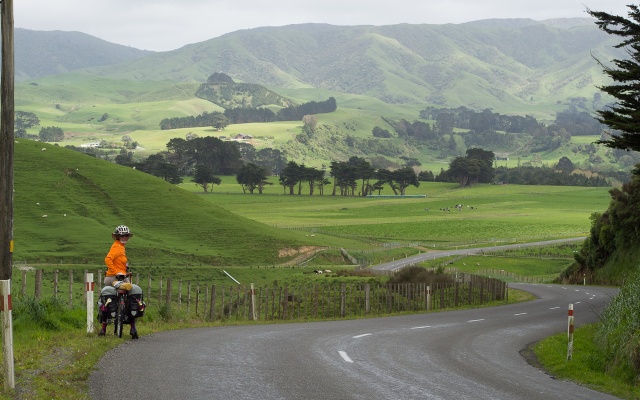
End.
Down and Out
(The day before this post we showed most of our Australia photos separately, here)
On a whistle stop tour of Brisbane we saw, nestled between the gleaming glass, chrome and concrete monoliths, red brick relics of bygone times. Churches and municipal buildings that document the Victorian birth of many of these towns. Staying in Sydney a little bit longer we delved beneath the high rise towers to find rows of terrace houses, churches, and curious institutes. That, together with the numerous parks, gave the place a spacious feel despite the flyover, and tunnel being built, to cope with the volume of traffic. Melbourne, with intimate lanes where eateries spread out across the road and waiters dance between pedestrians, also feels spacious with wide roads that accommodate tram lines, cycle lanes and cars. A pleasant mix of the old and new that have plenty of space to blend. And some very British (but better) public provision of toilets, benches, parks etc.

But it hasn’t been the history or lack of it that has been an inspiration in Australia but the abundance of wildlife; multitudes of marsupials that we’ve never seen before. The dazzling variety of birds swooping about, deafening at times. Flying foxes, echidna, wallabies and kangaroos, hump back whales and the occasional sighting of our immigrant friends rabbit, stoat and weasel. We finally, days before leaving, after many hours cycling with our necks craned up, genuinely saw a koala in the wild. We’d already visited Raymond Island’s koala tourist trek to tick that box, but it was awesome to see one snoozing in a mainland tree.

Having travelled for many months through Asia and South East Asia where, in rural areas especially, traditional methods of fishing and farming were still very evident, I was keen to see aspects of indigenous people, but we’ve had to seek out aboriginie heritage centres to get a view of their past, present and future. Sydney Museum spelt out the conflict and massacres that took place between the invading whites and the aboriginal people, while Rockhampton cultural centre and Melbourne Museum focused on the traditional way of life. The pride of the indigenous people was evident with videos showing younger generations learning traditional skills.

Mosaics were on display at the Eden Killer Whale Museum
We’ve also had conversations with many Australians, and learnt more that way. I was going to write that having in-depth discussions in English is also a novelty, after so long. But we met adept English speakers in India, Thailand and Singapore. Perhaps the difference is our willingness, maybe also the locals’ too, to discuss difficult issues.
While combine harvesters, trains and trucks have replaced Asia’s scythes, oxen and carts in Queensland’s sugar cane production, if any aboriginal people have managed to cling onto traditional ways of life it will be way out in the dry centre and west, well hidden from tourists like us. That’s one thing I suppose about the sort of life presented in books like “Walkabout” – it creates an association between aboriginal life and harsh land, whereas one thing that’s now clear to us is that the best of that life was in the good lands, such as we’ve been through, that our invaders nicked for farming.

It isn’t difficult to see how conflict has arisen as European values of exploiting the land with intensive and commercial farming, logging or miners culling the land before moving on are in direct conflict with aboriginal beliefs and practises that sustained flora and fauna. The land being ‘sacred’ – look after the land and the land will look after you.
Koalas, one iconic Australian animal, are doomed if the current rate of deforestation continues. 15 years, we were told, until loss of habit will result in no more koalas in the wild. Aborigines, however, made tree bark canoes from trees where, in time, the bark grows back, just one example of where they use the environment without destroying it.

The history of the aboriginal peoples connection with the land is displayed on information boards at key locations that explain the importance of each site often stating that it had been significant sight for 40000, 50000 or 60000 years. Never do they tell of the 200 hundred years it took to destroy it.
Of course, said “European” values didn’t just affect the Australian Aboriginals, this was the era of the Scottish Highlands clearances, Irish potato famine, Napoleon and Bismark invading everywhere, and colonies. Brutish dog-eat-dog behaviour at all levels. But in the British Empire, it does seem the Australian Aboriginals were uniquely ignored, politically, as in the other new lands, the indigenous population was formally recognised – although still shot, infected, or driven out. In Australia, the indigenous population were explicitly not people but listed as fauna until 1967. Yes, Nineteen. The image of aboriginal people in a line depicting Australian fauna at Sydney Museum has, in very recent years, been removed.
Whilst the east coast has certainly got it’s fair share of hills to pedal up and down which by the end of a day is knackering, the coastal views are breathing taking. Endless expanses of golden or white beaches as far as the eye can see. Red cliffs, Clifton Sea Bridge and numerous bays with blue sea contrasted by ripples of waves were highlights along the way. As we moved south into Victoria, the land became greener and more convoluted.
‘Git ou’ the waaay”. It took a moment or two for me to decipher this advice growled at us from a vehicle as it passed, but it was one of the least offensive we’ve received. Australia has been the first country were there has been occasional direct hostility towards us as cyclists, as well as a lot of truly dreadful passing. We’d read about this, and especially the road trains, online. It does seem that a lot of Aussie drivers, especially truckers, would rather trust to luck on blind bends, than ease off the loud pedal. Aussie truckers are probably the near-worst drivers we’ve encountered, after Indian bus drivers and their Indonesian colleagues. The notorious road trains didn’t seem especially bad, probably because they’re only on relatively empty roads with few bends.
One of the problems, we think, is over ambitious claims or misconceptions about the cycle tracks which may lead car drivers to consider that we are well provided for. Well, provided for we are by: disjointed, frequently poorly maintained, unsignposted and, at roundabouts in Cairns, the outright dangerous positioning of a cyclist should we use it. Sometimes we can use the hard shoulder, but it doesn’t always exist, and oftimes seems to have been deliberately ruined with road features placed down the centre of it. The concept of cycle tracks is a good one but they have to prove useful to cyclists. In the city of Newcastle they were, but elsewhere a lot of the facilities, as in England, had an air of local authority quota filling, and especially, almost no direction signs. Locals only, perhaps. But further south in Victoria, a series of rail trails have made very pleasant and productive traffic free cycling. Overall, in terms of road safety and comfort, most things improved steadily as we worked our way south.
Much more pleasantly memorable are the many helpful, friendly and very supportive folk who have stopped on their way, to give us gratefully received advice on better routes or attractions in the area. One such lady had us back track half a kilometer, head this way then that until we found an old mining road. It was right where the map displayed it but had failed to list it as a cycle track and too many such dirt roads aren’t suitable for our narrow tyres. Gebber Road, as it was called, was a good quality dirt road that took us through beautiful woodland (with numerous sightings of goanna, and a fine snake), past fields and mangrove swamps before emerging, several hours later along another small coastal road on our way to Tea Gardens (yes, that’s its name).
Yet more memorable are the folks we’ve stayed with, from Warm Showers, friends of friends, and folk we met on the road. Always interesting to talk to, too. Nick, Andrew, Mitch & Tanya, Grant, Bernie, Tony & Laurelle, Kirsten & Warwick – thank you all.
We’ve had plenty of moments where we’ve felt we weren’t going to cover the distance from Cairns to Melbourne within our three month visa. But, we’ve made it with time to spare managing to see many chosen sights along the way, and as so often, learning at least a little about the land, its wildlife, and its people.
Australia – Photos
Wow – what a lot of photos we took in Australia – getting on for a thousand each. Well, here’s a selection. There’s even more wildlife photos a few of which we’ll upload to the Birds and Beasties pages someday.
The Scenic Views, Part 1
The Scenic Views, Part 2
On the Road
Urban
Whale Watching
Hervey Bay, since you ask. Several times we saw whales from the coastal cliffs, down much of the SE coast. The humpbacks migrate that way.
The Best of the Rest of the Wildlife
The Holiday Snaps
End
Down Under
Tears welled up in my eyes as I sat on the promenade bench gazing out towards the sea, seagulls waiting expectantly. It could have been home.

We were like kids in a candy store picking out lunch as old favorites competed for our attention – coleslaw, hummus, fresh rolls, all there ready and waiting.
Our fabulous warm showers host, Nick, eased us back into civilization with his bachelor pad where his no clutter policy didn’t extend to the workshop.

Sunrise yoga on the beach
Following on from bike servicing, back servicing and a fantastic Barrier Reef dive trip we finally made a move where the sunshine state once again propelled us back home with three days of grey skies and drizzle. Our must see list dwindled: tree kangaroos that come out in the sunshine, cassowaries in the car park “just” 4 km away down a now mud track and platypus where we arrived at the camping book-in point four minutes too late. Rules is rules, I just apply them was the retort from the proprietor who showed no compassionate interpretation of them on this dismal day. Even the omnipresent kangaroos were nowhere to be seen. But the trail of unfortunate road kill victims enticed a splendid assortment of birds of prey down to the bitumen as we pedalled our way along. Low density woodland and grass scrub providing grazing for beef cattle and a few horses too.
Grassy verges need a ‘keep off’ warning sign as we learnt the hard way. A 12 metre shortcut across a grassy verge resulted in 20 min removing thorns from my tyres together with the rather predictable two slow punctures I fixed later. Down the road we became aware of another local hazard. Thankfully it is our helmets that testify to the magpies’ dive bombing habits. It also explains a local fashion of alien looking bike helmets with tie-wraps poking out of the top.
Having spent several days cycling through the Atherton Tablelands we headed back down to the coastal road. Not so remote as we cycle down south, we hope, but towns and roadhouses are still few and far between. As you’d expect the major highway is generally flatter but the traffic has increased considerably. You get used to the traffic, one blog article states.
At one campsite Gid came back from the shower with a spring in his step to declare that John, a grey nomad from a couple of vans down the park, had offered to show us on the map where we could get onto smaller roads by the coast. We tried in vain to find the place starting with Bene… something on our Queensland map. John joined us a little later spreading his ancient torn maps on the table where his accumulated notes told of adventures past. There he said, pointing to a town on the map just above Sydney. That’s the town; there’s the road. That’s good too, he enthused moving his finger down a bit. A little hilly though, helpfully writing hilly on the map. He added a few more notes as he continued down the coast explains the features as he went. Very kindly, he left his maps with us but we couldn’t help giggling that our hoped for escape from the main highways was six or seven weeks away and in a different state.
Wind lifted the shirts off our backs as we sailed past the Whitsunday Islands, pedal pushing all the way. A stab of regret shot through me as I visualized the tall ship, Solway Lass, that had been highly recommended as the perfect way to cruise between the National Park islands. Reality struck home. Firstly, it was stunningly expensive for budget conscious cyclists. Secondly, we’d only just got going and were very aware of time constraints. Thirdly, should we need another reason, I’d been extremely nauseous on our one day reef trip despite having taken sea sick pills.
Hotels with the occasional 3* luxury are a thing of the past. Now we’re scouting the electronic devices for camp sites, free if possible, with the latest ‘3* luxury’ being paid for sites with a shower. Aged backs grumble at our crawl-in tent. Ground level cooking, eating and packing all take their toll at the end of a day in the saddle. Campsite camaraderie, where spare food and water are readily offered and simple exchanges of a few words, are now deeper conversations. Another factor eating away at our time constraints as the grey nomads are only too happy to wile away a bit of time and keen to share adventures.
We’ve taken a while to get our heads round distances and the endless kilometers of nothing. Towns sprawl out with scrub land between single storey homes, dead-end roads lead out back, well worn wooden buildings and old Queenslander homes adding a touch of history along the way.
It’s around 3,700km from Cairns to Melbourne, by the coastal route. Let’s hope we don’t find it too tiring…
